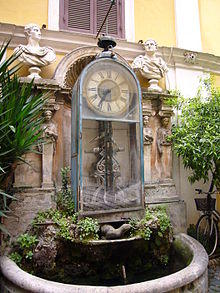A hydrochronometer is a kind of water clock.
In 1867 Fr. Giovan Battista Embriaco, O.P., inventor and professor of the College of St. Thomas in Rome, created a hydrochronometer[1] and sent it to the Paris Universal Exposition of 1867, where it received many prizes. It had the shape of a wooden pinnacle made of cast iron fused as tree trunks, while its four dials were visible from every direction.
In 1873, the Water clock was back in Rome and was placed in Villa Borghese gardens into a fountain realized by the architect Gioacchino Ersoch. It's still placed there and works 24/7.
In June 2007, after two years of restoration at ELIS School, it was restarted by the Town Mayor of Rome.
Another hydrochromometer can be found at Palazzo Berardi, rione Pigna, Rome.
Notes
- ^ "Orologi". Archived from the original on 5 December 2014. Retrieved 20 March 2013.
E' infatti del 1867 l'invenzione dell'idrocronometro, dovuta al padre domenicano Giovanni Battista Embriaco, che attese ai suoi studi di meccanica applicata all'orologeria nella solitudine del convento della Minerva.
.jpg)
